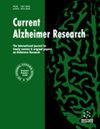多酚类五倍子单宁与阿尔茨海默病相关致淀粉样多肽的相互作用:从分子洞察到生理意义
IF 1.9
4区 医学
Q3 CLINICAL NEUROLOGY
引用次数: 0
摘要
:多酚是大量存在于植物中的天然化合物。众所周知,它们对人体健康有诸多益处,包括抗氧化特性和抗炎活性。有趣的是,许多研究表明,多酚还能调节与疾病相关的淀粉样纤维的形成,并能防止细胞毒性低聚物的形成。在这篇综述中,我们强调了四种具有高构象灵活性、低毒性和多靶点性的可水解五倍子单宁(HGTs),如单宁酸、五没食子酰葡萄糖、柯里拉京和 1,3,6-三-O-没食子酰-β-D-葡萄糖,对与阿尔茨海默病(AD)相关的淀粉样蛋白聚集的诸多影响。这些 HGTs 在不同程度上减少了与阿尔茨海默病有关的淀粉样纤维的形成,包括由淀粉样β肽、小管蛋白相关单位和胰岛淀粉样多肽组装而成的淀粉样纤维。研究还表明,HGTs 能分解预先形成的纤维,减轻小鼠认知能力的衰退。最后,本手稿强调了进一步研究这些天然存在的 HGTs 的重要性,这些 HGTs 是设计分子的有前途的支架,可以干扰与注意力缺失症发病机制相关的蛋白毒性寡聚体和聚集体的形成。本文章由计算机程序翻译,如有差异,请以英文原文为准。
Interactions of Polyphenolic Gallotannins with Amyloidogenic Polypeptides Associated with Alzheimer’s Disease: From Molecular Insights to Physiological Significance
: Polyphenols are natural compounds abundantly found in plants. They are known for their numerous benefits to human health, including antioxidant properties and anti-inflammatory activities. Interestingly, many studies have revealed that polyphenols can also modulate the formation of amyloid fibrils associated with disease states and can prevent the formation of cytotoxic oligomer species. In this review, we underline the numerous effects of four hydrolysable gallotannins (HGTs) with high conformational flexibility, low toxicity, and multi-targeticity, e.g., tannic acid, pentagalloyl glucose, corilagin, and 1,3,6-tri-O-galloyl-β-D-glucose, on the aggregation of amyloidogenic proteins associated with the Alzheimer’s Disease (AD). These HGTs have demonstrated interesting abilities to reduce, at different levels, the formation of amyloid fibrils involved in AD, including those assembled from the amyloid β-peptide, the tubulin-associated unit, and the islet amyloid polypeptide. HGTs were also shown to disassemble pre-formed fibrils and to diminish cognitive decline in mice. Finally, this manuscript highlights the importance of further investigating these naturally occurring HGTs as promising scaffolds to design molecules that can interfere with the formation of proteotoxic oligomers and aggregates associated with AD pathogenesis
求助全文
通过发布文献求助,成功后即可免费获取论文全文。
去求助
来源期刊

Current Alzheimer research
医学-神经科学
CiteScore
4.00
自引率
4.80%
发文量
64
审稿时长
4-8 weeks
期刊介绍:
Current Alzheimer Research publishes peer-reviewed frontier review, research, drug clinical trial studies and letter articles on all areas of Alzheimer’s disease. This multidisciplinary journal will help in understanding the neurobiology, genetics, pathogenesis, and treatment strategies of Alzheimer’s disease. The journal publishes objective reviews written by experts and leaders actively engaged in research using cellular, molecular, and animal models. The journal also covers original articles on recent research in fast emerging areas of molecular diagnostics, brain imaging, drug development and discovery, and clinical aspects of Alzheimer’s disease. Manuscripts are encouraged that relate to the synergistic mechanism of Alzheimer''s disease with other dementia and neurodegenerative disorders. Book reviews, meeting reports and letters-to-the-editor are also published. The journal is essential reading for researchers, educators and physicians with interest in age-related dementia and Alzheimer’s disease. Current Alzheimer Research provides a comprehensive ''bird''s-eye view'' of the current state of Alzheimer''s research for neuroscientists, clinicians, health science planners, granting, caregivers and families of this devastating disease.
 求助内容:
求助内容: 应助结果提醒方式:
应助结果提醒方式:


